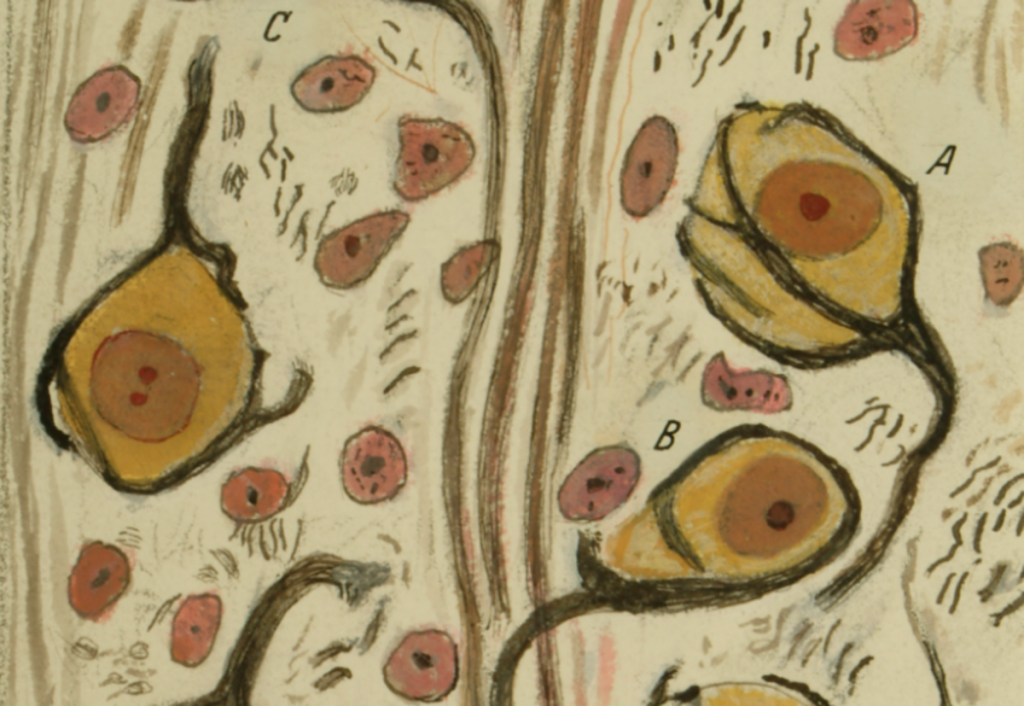Santiago Ramón y Cajal (1852-1934) is considered the father of modern neuroscience.
As a neuroanatomist, he examined super-thin pieces of brain under a microscope, treating them with chemical stains to reveal both different types of cells and the structures within the cells.
As an artist — his second vocation —he produced more than 2,900 drawings depicting the human nervous system over the course of 50 years.
“The Beautiful Brain: The Drawings of Santiago Ramón y Cajal” (Abrams, 2017, $30), features 80 of these stunning drawings. Some are familiar to Cajal aficionados; others have never before been published.
Cajal was born in Petilla de Aragón. As a teenager he was an obsessive collector and a prankster with an innate distrust of authority. His passions were drawing and photography. Following in his father’s footsteps, he entered medical school at Zaragoza, and graduated when he was 21.
During a year of army medical service in Cuba he contracted malaria, leaving him with a delicate constitution more suited to teaching than the more arduous physical practice of medicine.
“I finally chose the cautious path of histology, the way of tranquil enjoyments.” he wrote in his autobiography, “Recollections of My Life.”
Histology is the study of the microscopic structure of tissues. Cajal, it transpired, had chosen well.
“Once I spent twenty hours continuously at the microscope,” he wrote, “watching the movements of a sluggish leucocyte in its laborious efforts to escape from a blood capillary.”
The principal unanswered question of 19th-century neurology, notes USC neuroscientist Larry W. Swanson in an introductory essay, was how the nerve impulse is transmitted from one nerve cell to another in the adult nervous system.
What accounts for, say, the capacity of a sensory nerve cell to detect pain and of a motor nerve cell to move a muscle so as to avoid the pain? What is the cellular foundation of reflexes?
In 1873, Italian biologist and pathologist Camillo Golgi had accidentally discovered a method of staining cells.
Previously, nerve cells had appeared under the microscope bunched together in seemingly impenetrable tangles. Golgi’s method, by contrast, outlined the individual nerve cell in a deep, rich, black against a pale yellow background.
Nothing could have been more natural than for Cajal, examining such slides under his own microscope, to pick up pen, ink and paper.
Lyndel King, chief curator at the Frederick R. Weisman Art Museum in Minneapolis, and Eric Himmel, editor-in-chief at Abrams Books, contribute to the book a stellar essay centering on Cajal’s mastery of drawing.
At the time, they note, “explorers of the brain were very much in the same situation as astronomers.”
Cajal himself used a tree metaphor.
In 1894, he wrote, “The cerebral cortex is similar to a garden filled with innumerable trees, the pyramidal cells, which can multiply their branches thanks to intelligent cultivation, send their roots deeper, and produce more exquisite flowers and fruits every day.”
In effect, assert King and Himmel, Cajal’s artistic feat was tantamount to entering a forest of 100 billion trees equipped only with a sketchbook, and emerging with a top-notch field guide.
Notoriously hardworking, Cajal put in 15-hour days. Along with the drawings went important scientific discoveries.
At the time, the received wisdom was that the brain comprised one vast interconnected network. Cajal’s Neuron Doctrine, later proved to be correct, held by contrast that the nervous system is comprised of discrete individual cells that interact with one another through contact, rather than direct continuity.
In short, nerve cells communicate without touching.
He wrote: “1888 was my greatest year, my year of fortune … the new truth, laboriously sought and so elusive during two years of vain efforts, rose up suddenly in my mind like revelation. The laws governing morphology and connections of nerve cells in the gray matter, which became patent first in my studies of the cerebellum, were confirmed in all the organs I successively explored.”
In 1906, he and Camillo Golgi shared the Nobel Prize in Physiology or Medicine.
But for the layperson it’s the drawings — even today used in scientific lectures, medical school classes and textbooks — that enchant.
To the neuroscientist they may depict astrocytes, dendrites and axons. But to you and me they’re stars, clumps of seaweed, tree roots, pinwheels, filigree ferns, jellyfish, balloons, sunflowers, Edvard Munch’s “The Scream.”
A 1934 drawing of the calyces of Held (don’t ask) in a brainstem structure called the trapezoid body looks for all the world like a modernist rosebud. The cell structure depicted in “Ending of the Vestibular Nerve” could easily double as the tail of a peacock.
Whimsical yet sophisticated, many of the drawings are stand-alone works of art completely apart from their nervous system connection.
As King and Himmel note: “Since Cajal, we have seen mounting evidence that the idea of the brain being as vast and mysterious as the universe — for centuries a trope for poets — may contain some literal truth. When we look at his drawings today, we see not diagrams or arguments, but the first clear pictures of that remote frontier, drawn by the man who traveled farthest into its endless reaches.”

